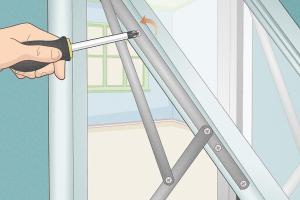Mastering the Art of Adjusting uPVC Windows: A Complete Guide

-
Quick Links:
- Introduction
- Understanding uPVC Windows
- Common uPVC Window Problems
- Tools Required for Adjustment
- Step-by-Step Adjustment Guide
- Case Studies: Real-World Adjustments
- Expert Insights on uPVC Window Maintenance
- Conclusion
- FAQs
Introduction
uPVC windows are a popular choice in modern homes due to their durability, low maintenance, and energy efficiency. However, like any home feature, they may require adjustments over time. This comprehensive guide will provide you with everything you need to know about adjusting uPVC windows, ensuring they function optimally and enhance your home's energy efficiency.
Understanding uPVC Windows
uPVC (unplasticized polyvinyl chloride) windows are designed to withstand the test of time. They are resistant to rot, corrosion, and fading, making them an ideal choice for both residential and commercial properties. Understanding how they function is crucial for effective adjustment.
Benefits of uPVC Windows
- Low maintenance requirements
- Excellent thermal insulation
- High durability and weather resistance
- Cost-effective compared to traditional materials
Common uPVC Window Problems
Despite their advantages, uPVC windows may encounter several issues that necessitate adjustment. Understanding these problems can help you address them effectively.
1. Misalignment
Misaligned windows can lead to drafts, increased energy bills, and water ingress. Signs of misalignment include difficulty in opening or closing the window and gaps between the window frame and sash.
2. Sticking Windows
If your uPVC windows are sticking, it could be due to swelling from moisture or hinges that require lubrication.
3. Broken Seals
Broken seals can lead to condensation between the glass panes, which compromises energy efficiency and aesthetics.
Tools Required for Adjustment
Before you begin adjusting your uPVC windows, gather the following tools:
- Flathead screwdriver
- Phillips screwdriver
- Allen wrench set
- Measuring tape
- Lubricant (silicone spray or similar)
Step-by-Step Adjustment Guide
Follow these steps to adjust your uPVC windows effectively:
Step 1: Inspect the Window
Begin by inspecting the window for any visible issues, including misalignment, broken seals, or damaged hardware.
Step 2: Adjust the Hinges
Hinges are crucial for the smooth operation of your windows. Here’s how to adjust them:
- Locate the hinge screws on the frame and sash.
- Use the appropriate screwdriver to tighten or loosen the screws as needed.
- Check the alignment by closing the window and observing any gaps.
Step 3: Adjust the Locking Mechanism
If the window doesn’t lock properly, the locking mechanism may need adjustment. Follow these steps:
- Locate the locking points along the sash.
- Use an Allen wrench to adjust the position of the lock.
- Test the lock to ensure it engages correctly.
Step 4: Lubricate Moving Parts
Applying lubricant to the hinges and locks can enhance their performance. Use a silicone spray to avoid attracting dirt and debris.
Case Studies: Real-World Adjustments
Examining real-life scenarios can provide insight into effective adjustment techniques.
Case Study 1: Misaligned Window in a Coastal Home
A homeowner in a coastal area noticed their uPVC windows were misaligned, causing drafts. After inspecting the hinges, they adjusted them by tightening the screws. This simple fix improved the window's performance significantly.
Case Study 2: Sticking Window in a Humid Environment
In a humid region, a family found their uPVC windows sticking. They applied lubricant to the hinges, which resolved the issue and restored functionality.
Expert Insights on uPVC Window Maintenance
Experts recommend regular maintenance checks to ensure uPVC windows remain in top condition. This includes cleaning the frames, checking the seals, and lubricating the moving parts at least once a year.
Conclusion
Adjusting uPVC windows is a straightforward process that can significantly enhance your home's comfort and energy efficiency. By understanding common problems and following the steps outlined in this guide, you can keep your windows functioning optimally for years to come.
FAQs
1. How often should I adjust my uPVC windows?
It is advisable to check your uPVC windows at least once a year for any signs of misalignment or wear.
2. Can I adjust uPVC windows myself?
Yes, adjusting uPVC windows is a DIY-friendly task that requires basic tools and knowledge of the window components.
3. What tools do I need to adjust uPVC windows?
You will need screwdrivers, an Allen wrench set, a measuring tape, and lubricant.
4. What causes uPVC windows to become misaligned?
Misalignment can occur due to settling of the building, changes in temperature, or wear and tear on the hinges.
5. How do I know if my window seal is broken?
Look for condensation between the glass panes or noticeable drafts when the window is closed.
6. Can I replace broken seals myself?
Replacing seals may require professional assistance, but minor repairs can be DIY if you have the right materials.
7. What type of lubricant should I use?
Use a silicone-based lubricant, as it won’t attract dirt and will help maintain the moving parts.
8. Are there any signs that my uPVC windows need adjustment?
Signs include difficulty opening or closing the window, gaps in the frame, and drafts.
9. How can I prevent my uPVC windows from misaligning?
Regular maintenance, including cleaning and lubrication, can help prevent misalignment.
10. Is it worth adjusting my uPVC windows?
Yes, proper adjustments improve energy efficiency, enhance security, and extend the lifespan of your windows.
Random Reads
- How to change windows password command prompt
- How to check if iphone is unlocked
- How to check if port is open
- How to die in minecraft
- How to cover a balcony from rain
- How to countersink a screw
- How to replace fluorescent lighting
- How to replace flat roof
- How to clean travertine for a beautiful shine
- How to place an ad on gumtree